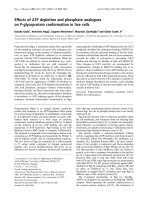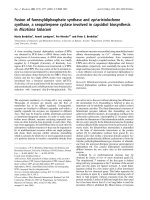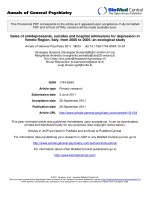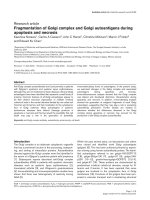Báo cáo y học: "Management of HCV Infection and Liver Transplantation"
Bạn đang xem bản rút gọn của tài liệu. Xem và tải ngay bản đầy đủ của tài liệu tại đây (403.84 KB, 5 trang )
Int. J. Med. Sci. 2006, 3
79
International Journal of Medical Sciences
ISSN 1449-1907 www.medsci.org 2006 3(2):79-83
©2006 Ivyspring International Publisher. All rights reserved
Review
Management of HCV Infection and Liver Transplantation
Thomas D. Schiano, and Paul Martin
Adult Liver Transplantation, Recanati/Miller Transplantation Institute, Division of Liver Diseases, Department of Medicine, The
Mount Sinai School of Medicine, New York, NY, USA
Corresponding address: Thomas D. Schiano, M.D., The Division of Liver Diseases, Recanati-Miller Transplantation Institute, Box
1104, The Mount Sinai Medical Center, One Gustave Levy Place, New York, New York 10029. Phone: (212) 241-1424, (212) 241-
1598. Fax: (212) 241-2138. Email: ,
Received: 2005.12.30; Accepted: 2006.03.01; Published: 2006.04.01
A major challenge facing liver transplant recipients and their physicians is recurrence of hepatitis C virus infection
following otherwise technically successful liver transplantation. Recurrent infection leads to diminished graft and
patient survival. Although a number or predictors of severe recurrence have been identified, no definitive strategy has
been developed to prevent recurrence. Generally the tempo of hepatitis C recurrence is gauged by serial liver biopsies
with the decision to intervene with antiviral therapy based on local philosophy and expertise. Treating hepatitis C in
this population has a number of major challenges including diminished patient tolerance for side-effects as well as
managing the patient’s immunesuppression. However sustained viral responses are possible with the potential to
reduce the impact of recurrent hepatitis on the graft. However recurrent hepatitis C virus infection will remain the most
frequent form of recurrent disease in liver transplant programs for the foreseeable future.
Key words: recurrent hepatitis C, liver transplantation, antiviral therapy
1. Treatment of HCV in the Liver Transplant
Population
Currently there are approximately 17,000 patients on
liver transplant waiting lists throughout the U.S. with
approximately 5,000 liver transplants performed annually
[1,2]. Because of a critical shortage of donor livers, 10%-
12% of potential recipients die before they are
transplanted. About 40% of liver transplants are
performed in patients having HCV and this number is
expected to significantly rise during the next decade,
especially with burgeoning rates of hepatocellular
carcinoma [2,3]. Traditionally, cirrhotic patients were not
considered as candidates for interferon therapy as it was
believed that in the setting of hepatic encephalopathy,
ascites and protein malnutrition they would not tolerate
therapy and also that their liver disease would potentially
decompensate with treatment. However, improved
response rates using the combination of pegylated
interferon and ribavirin, greater experience in using
hematopoietic growth factor and the need to proactively
treat patients on the liver transplant waiting list have all
stimulated interest in treating HCV patients with cirrhosis
[1,4,5]. For the foreseeable future most HCV infected
transplant candidates will be viremic at the time of
transplant and will therefore remain at risk for recurrent
infection. The therapy of HCV post-OLT has evolved to
the point where most centers base treatment decisions on
the tempo of HCV recurrence on serial liver biopsies
although more and larger scale studies are needed in this
population.
2. Hepatitis C Post-Liver Transplantation
In liver transplant (LT) recipients, persistence of
hepatitis C (HCV) infection in viremic recipients almost
always leads to graft reinfection. In fact, serum viral titers
may reach pre-transplant levels within the first few days
post-operatively. Serum levels of HCV RNA peak 1-3
months post-transplant, reaching titers many fold higher
than pre-transplant levels [4,6]. Furthermore, histological
evidence of HCV recurrence occurs in over 90% of
patients within 5 years of the transplant and has a variable
clinical course [1,6]. Histological progression of HCV is
accelerated after LT and can result in the fairly rapid
development of graft failure and cirrhosis [7,8,9]. Several
studies have shown that as many as 20% of HCV patients
undergoing liver transplant may develop cirrhosis within
5 years, with almost 50% developing cirrhosis within a
decade. Once patients develop cirrhosis from recurrent
HCV, they are at risk for the same complications as other
patients including variceal bleeding, ascites and
hepatocellular carcinoma. Berenguer and colleagues
observed rapid hepatic decompensation in LT recipients
with graft cirrhosis due to recurrent HCV [1,4,10].
Recent studies looking at large numbers of patients
with adequate long-term follow-up have confirmed that
patients with HCV undergoing liver transplantation have
increased morbidity and mortality and have lower 5 and
10 year survival rates when compared to patients
undergoing liver transplantation for other etiologies of
cirrhosis [1,8,9]. HCV is the most frequent indication for
LT in the United States and in Europe. By the year 2020
the proportion of untreated HCV patients developing
cirrhosis is expected to increase by 30%, the number of
cirrhotic patients with HCV to increase by 100%, and the
number of HCV cirrhotic patients developing
hepatocellular carcinoma by 80% [2]. With the anticipated
increase in patients requiring LT for HCV related liver
disease, development of effective strategies to reduce graft
failure due to HCV recurrence is essential.
A number of reports have described accelerated
fibrosis progression post-liver transplantation and this
may in part be due to the age of the donor liver allograft
[10]. The median rate of fibrosis progression is between
0.3 and 0.6 stage per year post-transplant compared to 0.1
to 0.2 stage per year in immunocompetent HCV patients.
Various risk factors for poor outcomes post-LT for HCV
Int. J. Med. Sci. 2006, 3
80
have been described. Berenguer et al have shown that the
use of liver allografts from deceased donors older than
age 60 is associated with a more severe recurrence of HCV
as well as a more rapid progression to cirrhosis when
compared to LT recipients receiving allografts from
younger donors [10]. Once patients develop cirrhosis
post-transplant, the 1 and 3 year actuarial risks of
decompensation are 42% and 62%, respectively, vs. less
than 5% by 1 year and less than 20% by 5 years in
immunocompetent patients with chronic HCV infection
[1,4,5]. A subset of patients develop a severe cholestatic
form of HCV that rapidly progresses to graft failure,
similar to the fibrosing cholestatic hepatitis that originally
described in patients with recurrent hepatitis B post-
transplant. Characteristically, there is a very high HCV
serum RNA level, profound hyperbilirubinemia and high
levels of alkaline phosphatase and gamma-glutamyl
transferase, and liver biopsy reveals feathery degeneration
predominantly in the perivenular area (Figure 1), portal
tracts showing chronic inflammation ranging from mild-
severe with occasional lymphoid aggregates (Figure 2)
[4,11]. Actively proliferating bile ductiles are often seen.
Risk factors for severe recurrent HCV include advanced
donor age, HCV genotype 1, high HCV RNA levels before
and after transplant, early histological recurrence of HCV,
concomitant cytomegaloviral infection, the use of T
lymphocyte-depleting immunosuppressive agents such as
OKT3, and treatment of presumed acute cellular rejection
with pulse corticosteroids. Data are conflicting as to
whether recipient age, warm or cold ischemia times,
gender, HLA mismatch, ethnicity or pre-transplant
severity of illness influence the rate of recurrent HCV and
its severity [1,4,5,12,13,14].
Figure 1. Liver needle biopsy showing severe recurrent hepatitis C, cholestatic type. This photomicrograph shows centrilobular
cholestasis causing feathery degeneration of hepatocytes (long arrow). In addition, there are foci of parenchymal necrosis including
acidophilic bodies (short arrows). H&E stain, original magnification 200x.
Excessive immunosuppression appears to have a deleterious effect on HCV recurrence post-liver transplant [1,15].
High dose maintenance corticosteroid therapy for the prevention of acute cellular rejection has been associated with
decreased patient and graft survival in HCV-infected transplant recipients. With regard the use of cyclosporine- or
tacrolimus-based immunosuppression, no significant differences in survival or in frequency/severity of HCV
recurrence have been found. The impact, if any, of azathioprine, mycophenolate mofetil and sirolimus on HCV natural
history post-liver transplant remain unclear [1,5]. It can be extremely difficult at times to differentiate between acute
cellular rejection and recurrent HCV histologically even for experienced liver pathologists because most patients will
have some baseline features of hepatitis on the biopsy, as well as varying degrees of the histological features that define
allograft rejection such as interface inflammatory changes and bile duct damage [4,16]. Thus, repeated liver biopsies
may be required when there is an elevation in liver chemistry tests to more reliably diagnose HCV recurrence. The
optimal strategy in managing immunosuppression post-liver transplant in the HCV patient thus appears to be
achieving a balance between the prevention of rejection while minimizing the potential deleterious effects of
immunosuppression on recurrent HCV [1,4]. However, this is extremely difficult to achieve in most patients.
In the post-liver transplant setting the differential diagnosis of elevated liver chemistry tests is broad and includes
acute cellular or chronic ductopenic rejection, bacterial or viral (CMV most frequently) infection, drug hepatotoxicity,
ischemia or viral hepatitis. Approximately 20-30% of patients with recurrent HCV may have normal aminotransferases;
it is for this reason that some centers favor protocol liver biopsies in HCV patients post-liver transplantation.
Histologically, acute HCV recurrence is characterized by lobular infiltrates with varying degrees of hepatocyte necrosis
Int. J. Med. Sci. 2006, 3
81
which may evolve over time to a chronic hepatitis with significant portal and lobular infiltrates and hepatocyte necrosis,
as well as portal-to-portal bridging fibrosis.
Early in the era of adult-to-adult live donor liver transplantation, preliminary reports suggested that patients
undergoing this partial liver transplant had more severe HCV recurrence [1,4]. Although a well designed study from
Europe did show a higher rate of graft failure in HCV recipients of live donor liver transplantation as compared to
HCV(+) recipients of deceased donor livers, several more recent studies including one utilizing protocol liver biopsies
and another an analysis of the UNOS database of a large number of patients, have not shown worse graft or patient
survival in patients undergoing live donor liver transplantation [17,18].
Several studies have shown that patients undergoing retransplantation for recurrent HCV experience significant
morbidity and mortality. Although there is decreased patient and graft survival after retransplantation in general, it
appears that results are even poorer for patients when the etiology of graft failure is recurrent HCV. In a large single
center experience Roayaie et al noted a median survival of 12.9 months in 42 patients undergoing retransplantation
because of graft failure due to recurrent HCV; 20 of the patients died within 6 months, almost all from sepsis. The
presence of renal dysfunction, thrombocytopenia and coagulopathy were negative prognostic variables for survival [19].
Whether to retransplant patients with recurrent HCV is a difficult decision because of the decreased patient and graft
survival that occurs after retransplantation in an era in which there are frequent deaths on the liver transplant waiting
list and a finite number of donor livers. Whether a patient with HCV recurrence was unable to tolerate interferon
treatment or was a virological non-responder must be considered in the decision making process when
retransplantation becomes necessary, although data on this point is needed.
Figure 2. Same case as above showing a portal area with a dense lymphoid aggregate typically seen in chronic hepatitis C. Arrows
point to proliferating bile ductules (ductular reaction). The bile duct is intact albeit slightly damaged. H&E stain, original
magnification 200x.
Currently, interferon-based therapies are the only
effective treatment for HCV post-liver transplantation.
Treatment early after liver transplant is difficult because
of the patient's often poor performance status, their
increased susceptibility to infection and rejection, and the
presence of anemia and renal dysfunction that lessen the
tolerability of interferon and ribavirin [1,4,5,20,21]. It is
for these reasons, in addition to the fact that an
undetectable or low viral load at the time of transplant is
associated with less severe HCV recurrence, that pre-
transplant antiviral therapy is frequently attempted [22].
To date, preemptive treatment to prevent HCV recurrence
post-liver transplantation has not been shown to be highly
effective; Chalasani et al recently demonstrated less than a
10% sustained virological response rate in patients
receiving 48 weeks of peginterferon alfa-2a monotherapy
[23]. The First ILTS Expert Panel Consensus Conference
concluded that prophylactic and preemptive antiviral
interferon-based therapy should only be used in specific
circumstances, such as for non-HCV patients receiving
HCV (+) donor allografts [4]. The response rate with
standard interferon monotherapy and standard interferon
in combination with ribavirin to treat post-liver transplant
HCV has generally been associated with modest response
rates. However, small single center trials in patients
treating established recurrent HCV using the combination
of pegylated interferon alpha-2b and ribavirin have
resulted in end-of-treatment and sustained virological
response rates ranging from 27-64% and 0-36%,
respectively [24,25]. Treatment of recurrent HCV is
limited by decreased patient tolerability necessitating
frequent dose adjustment and the inability to achieve
optimal dosing. Approximately 30% of patients will
discontinue therapy. Often the only way of maintaining
Int. J. Med. Sci. 2006, 3
82
the blood counts is to aggressively use hematopoietic
growth factors. The often poor tolerability of this
population to any interferon and ribavirin regimen
reflects a number of factors including concomitant
immunosuppressive agents and associated renal
dysfunction. An important concern has been whether
interferon can induce graft rejection as has been reported
in renal transplant recipients. Chalasani et al in their
controlled clinical trial did not observe any increase in
rejection rates in liver transplant recipients treated with
pegylated alfa-2a [23]. Stravitz et al have described
profound graft dysfunction following successful
interferon clearance of HCV RNA with a picture
suggestive of chronic ductopenic rejection [26]. One
explanation may be that following clearance of HCV
infection hepatocellular function improves and in turn
leads to rejection. There have been increasing reports of
pegylated interferon and ribavirin therapy possibly
increasing the rates of both acute cellular and chronic
ductopenic rejection [23]. Castells et al in a recent report
described an SVR of 34% in genotype 1patients treated a
mean of 3.4 months following OLT suggesting a role for
therapy early in the course of HCV. Importantly a
predictor of interferon response was an absence of
treatment for acute rejection [28].
At our institution, patients with HCV undergo
protocol liver biopsies every 6 months, and interferon and
ribavirin are started only in the presence of progressive
fibrosis. Firpi and colleagues from the University of
Florida have described an important prognostic role for
the severity of liver biopsy findings 1 year post-OLT [29].
We utilize an escalating dose regimen of both pegylated
interferon and ribavirin, and we aggressively utilize
hematopoietic growth factors early in treatment to help
stave off the need to discontinue therapy. Although
thrombocytopenia may persist after portal hypertension
resolves post-transplant, it is rarely a limiting factor to
pegylated interferon use. We treat patients for 12 months
and check monthly laboratory testing to exclude acute and
chronic rejection.
The worsening organ donor shortage has
necessitated the use of HCV (+) allografts in recipients
with HCV. It appears that short-term patient and graft
survival are similar compared with a cohort of HCV (+)
recipients receiving HCV (-) allografts. A HCV (+) patient
who is HCV RNA (-) should not receive a HCV (+)
allograft. As it appears that the donor allograft genotype
predominates after transplantation, our center's practice is
to not use HCV (+) donors for patients with genotype 2
and 3 [4,5]. It is prudent to avoid the use of HCV (+)
livers from older donors or those having any histological
damage.
Conflict of Interest
The authors have declared that no conflict of interest
exists.
References
1. Brown RS. Hepatitis C and liver transplantation. Nature
2005;436:973-8.
2. Davis GL, Albright JE, Cook SF, Rosenberg DM. Projecting future
complications of chronic hepatitis C in the United States. Liver
Transpl 2003;9:331-8.
3. El-Serag HB. Hepatocellular carcinoma: recent trends in the United
States. Gastroenterology 2004;127:S27-34.
4. Wiesner RH, Sorrell M, Villamil F and the International Liver
Transplantation Society Expert Panel. Report of the first international
liver transplantation society expert panel consensus conference on
liver transplantation and hepatitis C. Liver Transpl 2003;9:S1-S9.
5. Vargas HE, Rodriguez-Luna H. Management of hepatitis C virus
infection in the setting of liver transplantation. Liver Transpl 2005;
11:479-89.
6. Charlton M. Liver biopsy, viral kinetics, and the impact of viremia
on severity of hepatitis C virus recurrence. Liver Transpl 2003;9:S58-
S62.
7. Chopra KB, Demetris AJ, Blakolmer K, Dvorchik I, Laskus T, Wang
LF, Araya VR, Dodson F, Fung JJ, Rakela J, Vargas HE. Progression
of liver fibrosis in patients with chronic hepatitis C after orthotopic
liver transplantation. Transplantation 2003;76:1487-1491.
8. Gane EJ, Portmann BC, Naoumov NV, Smith HM, Underhill JA,
Donaldson PT, Maertens G, Williams R. Long-term outcome of
hepatitis C infection after liver transplantation. N Engl J Med
1996;334:815-820.
9. Forman LM, Lewis JD, Berlin JA, Feldman HI, Lucey MR. The
association between hepatitis C infection and survival after
orthotopic liver transplantation. Gastroenterology 2002;122:889-96.
10. Berenguer M, Prieto M, San Juan F, Rayon JM, Martinez F, Carrasco
D, Moya A, Orbis F, Mir J, Berenguer J. Contribution of donor age to
the recent decrease in patient survival among HCV-infected liver
transplant recipients. Hepatology 2002;36:202-210.
11. Doughty AL, Spencer JD, Cossart YE, McCaughan GW. Cholestatic
hepatitis after liver transplantation is associated with persistently
high serum hepatitis C virus RNA levels. Liver Transpl Surg
1998;4:15-21.
12. Burak KW, Kremers WK, Batts KP, Wiesner RH, Rosen CB,
Razonable RR, Paya CV, Charlton MR. Impact of cytomegalovirus
infection, year of transplantation, and donor age on outcomes after
liver transplantation for hepatitis C. Liver Transpl 2002;8:362-369.
13. Charlton M, Seaberg E. Impact of immunosuppression and acute
rejection on recurrence of hepatitis C: results of the National Institute
of Diabetes and Digestive and Kidney Diseases Liver
Transplantation Database. Liver Transpl Surg 1999;5:S107-S114.
14. Ghobrial RM, Steadman R, Gornbein J, Lassman C, Holt CD,
Chen P, Farmer DG, Yersiz H, Danino N, Collisson E, Baquarizo A,
Han SS, Saab S, Goldstein LI, Donovan JA, Esrason K, Busuttil RW.
A 10-year experience of liver transplantation for hepatitis C: analysis
of factors determining outcome in over 500 patients. Ann Surg
2001;234:384-393.
15. McCaughan GW, Zekry A. Impact of immunosuppression on
immunopathogenesis of liver damage in hepatitis C virus-infected
recipients following liver transplantation. Liver Transpl 2003;9:S21-
S27.
16. Demetris AJ, Belle SH, Hart J, Lewin K, Ludwig J, Snover DC, Tillery
GW, Detre K. Intraobserver and interobserver variation in the
histopathological assessment of liver allograft rejection. The Liver
Transplantation Database (LTD) Investigators. Hepatology
1991;14:751-5.
17. Baltz AC, Trotter JF. Living donor liver transplantation and hepatitis
C. Clin Liver Dis 2003;7:651-665.
18. Russo MW, Galanko J, Beavers K, Fried MW, Shrestha R. Patient
and graft survival in hepatitis C recipients after adult living donor
liver transplantation in the United States. Liver Transplant
2004;10:340-346.
19. Roayaie S, Schiano TD, Thung SN, Emre SH, Fishbein TM, Miller
CM, Schwartz ME. Results of retransplantation for recurrent
hepatitis C. Hepatology 2003;38:1428-36.
20. Crippin JS, McCashland T, Terrault N, Sheiner P, Charlton MR. A
pilot study of the tolerability and efficacy of antiviral therapy in
hepatitis C virus-infected patients awaiting liver transplantation.
Liver Transpl. 2002;8:350-5.
21. Shakil AO, McGuire B, Crippin J, Teperman L, Demetris AJ,
Conjeevaram H, Gish R, Kwo P, Balan V, Wright TL, Brass C, Rakela
J. A pilot study of interferon alfa and ribavirin combination in liver
transplant recipients with recurrent hepatitis C. Hepatology
2002;36:1253-1258.
22. Everson GT, Trotter J, Forman L, Kugelmas M, Halprin A, Fey B, Ray
C. Treatment of advanced hepatitis C with a low accelerating dosage
regimen of antiviral therapy. Hepatology 2005;42:255-62.
Int. J. Med. Sci. 2006, 3
83
23. Chalasani N, Manzarbeitia C, Ferenci P, Vogel W, Fontana RJ, Voigt
M, Riely C, Martin P, Teperman L, Jiao J, Lopez-Talavera JC; Pegasys
Transplant Study Group. Peginterferon α2a for hepatitis C after liver
transplantation: two randomized, controlled trials. Hepatology
2005;41:289-298.
24. Rodriguez-Luna H, Khatib A, Sharma P, De Petris G, Williams JW,
Ortiz J, Hansen K, Mulligan D, Moss A, Douglas DD, Balan V,
Rakela J, Vargas HE. Treatment of recurrent hepatitis C infection
after liver transplantation with combination of pegylated interferon
alpha2b and ribavirin: an open-label series. Transplantation
2004;77:190-194.
25. Neff GW, Montalbano M, O'Brien CB, Nishida S, Safdar K, Bejarano
PA, Khaled AS, Ruiz P, Slapak-Green G, Lee M, Nery J, De Medina
M, Tzakis A, Schiff ER. Treatment of established recurrent hepatitis
C in liver-transplant recipients with pegylated interferon-alfa-2b and
ribavirin therapy. Transplantation 2004;78:1303-1307.
26. Stravitz RT, Shiffman ML, Sanyal AJ, Luketic VA, Sterling RK,
Heuman DM, Ashworth A, Mills AS, Contos M, Cotterell AH, Maluf
D, Posner MP, Fisher RA. Effects of interferon treatment on liver
histology and allograft rejection in patients with recurrent hepatitis
C following liver transplantation. Liver Transplant 2004;10:850-858.
27. Saab S, Kalmaz D, Gajjar NA, Hiatt J, Durazo F, Han S, Farmer DG,
Ghobrial RM, Yersiz H, Goldstein LI, Lassman CR, Busuttil RW.
Outcomes of acute rejection after interferon therapy in liver
transplant recipients. Liver Transplant 2004;10:859-867.
28. Castells L, Vargas V, Allende H, Bilbao I, Luis Lazaro J, Margarit C,
Esteban R, Guardia J. Combined treatment with pegylated
interferon (alpha-2b) and ribavirin in the acute phase of hepatitis C
virus recurrence after liver transplantation. J Hepatol 2005;43:53-9.
29. Firpi RJ, Abdelmalek MF, Soldevila-Pico C, Cabrera R, Shuster JJ,
Theriaque D, Reed AI, Hemming AW, Liu C, Crawford JM, Nelson
DR. One-year protocol liver biopsy can stratify fibrosis progression
in liver transplant recipients with recurrent hepatitis C infection.
Liver Transpl 2004;10:1240-7.
Author biography
Thomas D. Schiano, M.D. is Associate Professor of
Medicine, Medical Director of Liver Transplantation and
Director of Clinical Hepatology at The Mount Sinai
Medical Center, New York. His current research interests
include the diagnosis and management of hepatitis C in
the peri-liver transplant period, as well as the
management of the complications of chronic liver
diseases.
Paul Martin M.D. is Professor of Medicine at Mount Sinai
School of Medicine New York and Associate Director of
the Division of Liver Diseases. He has a major interest in
the management of viral hepatitis in organ transplantation
and chronic kidney disease.









